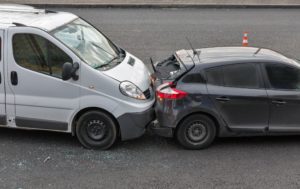 Automated safety systems may have reduced the number of rear-end crashes, but thousands still occur every year in Georgia. If you or a family member were injured or killed in a rear-end collision, you may be able to obtain compensation for your medical bills and property damage, among other things.
Automated safety systems may have reduced the number of rear-end crashes, but thousands still occur every year in Georgia. If you or a family member were injured or killed in a rear-end collision, you may be able to obtain compensation for your medical bills and property damage, among other things.
Call a Macon rear-end collision lawyer today to discuss your legal options and get started on a strong case.
Determining Liability in a Rear-End Accident
In the realm of personal injury, “liability” refers to a person’s responsibility for their actions. That person will be liable for damages that result from their failure to act responsibly.
For example, in the case of a car accident, a person who texts and drives and causes an accident would be liable for any injuries or property damage caused in the accident. Every driver is expected to follow the rules of the road, and if they fail to do so, they will be liable for any damages caused.
Regarding liability, rear-end accidents are usually straightforward. After all, the premise of a rear-end crash is that one car slammed into another from behind – the car in front wouldn’t have known or couldn’t prevent the other car from hitting them.
That’s usually the case, but sometimes liability is a little more complex.
Usually, the driver of the vehicle in the back is liable for damages. A typical argument would go along these lines: if they had been more careful and followed the rules of the road, the accident wouldn’t have happened in the first place.
Here are a few laws pertaining to negligent drivers and rear-end collisions:
Following Too Closely
O.C.G.A. 40-6-49 states: “The driver of a motor vehicle shall not follow another vehicle more closely than is reasonable and prudent (acting or showing care), having due regard for the speed of such vehicles and the traffic upon and the condition of the highway.”
A good rule of thumb for keeping a safe distance is to stay as far back as it takes to see the back tires of the car in front of you. If you can’t see their back tires, you’re probably too close.
Reckless Driving
O.C.G.A. 40-6-390 states: “Any person who drives any vehicle in reckless disregard for the safety of persons or property commits the offense of reckless driving.”
In Georgia, reckless driving includes forceful merging, weaving, driving at dangerously high speeds, tailgating, or cutting other drivers off.
Fault Isn’t Always Obvious in Rear-End Collisions
In rear-end collisions, the vehicle following behind the other is usually at fault – usually, but not always. There are a few circumstances where the lead driver may be at fault in the accident:
- Driving with broken brake lights
- Drunk driving
- Reversing into the rear car
If you were hit by the car in front of you, you shouldn’t assume that you’re out of legal options. As explained in these examples, there are circumstances where the driver in front may be to blame for causing an accident.
Your best bet is to contact a Macon rear-end collision lawyer to discuss your options and work toward proving the other driver’s liability.
Modified Comparative Fault in Georgia
Georgia is one of 33 states that follow the modified comparative fault rule (modified comparative negligence). This means that the accident victim cannot recover damages if they are more than 49% at fault for the collision.
Simple enough, but 12 of the 33 states that recognize modified commemorative negligence also recognize the 50% Bar Rule, Georgia being one of them. This rule states that accident victims may recover damages if they are 49% or less at fault, though the recovery amount will be reduced by their degree of fault.
For example, if the recovery amount is $100,000 and the accident victim is found to be 30% at fault, they’ll be able to recover $70,000.
The only way you’ll be able to recover the maximum amount of compensation is by hiring an experienced Macon rear-end accident lawyer. Attorneys know the tricks that defendants and insurance companies try to pull to evade responsibility, and they’ll help establish liability, defend your legal rights, and represent your best interests.
Call today for more information and to schedule a consultation with an attorney.
Types of Damages in a Rear-End Auto Accident
Depending on the circumstances of the crash, you may be able to recover one or more of the following types of damages: economic, non-economic, and punitive.
Economic Damages
By definition, economic damages are those related directly to the accident for which you’ll receive a bill or lose money from. Economic damages include:
- Medical bills, including hospital visits, doctor appointments, and ambulance rides
- Surgery
- Diagnostic studies, including MRIs, CT scans, and X-rays
- Medication/pharmaceuticals
- Medical equipment
- Replacement or repair costs for property damage (vehicle damage, damage to belongings in the car at the time of the crash, etc.)
- Lost income
This is the time to step in and help your lawyer calculate your damages. Hold on to all the receipts or bills that you’ve accumulated in the months following the accident; collect your medical bills, pay stubs, statements, and estimates.
Non-Economic Damages
Some of the most serious losses are without a price tag. There’s no bill or statement attached, but the loss is still there. In certain situations, you can recover non-economic damages like:
- Pain and suffering
- Loss of consortium (consortium refers to the right of a married couple to certain benefits like comfort, love, affection, and fellowship)
- Mental distress or anguish
- Disfigurement
- Physical impairment that prevents the injured party from enjoying or participating in hobbies or activities they formerly enjoyed
Non-economic damages are often more difficult to prove than economic damages, but with the help of a knowledgeable Macon rear-end accident lawyer, you could recover these losses and work toward getting back on your feet.
Common Types of Injuries in Rear-End Accidents

When another vehicle hits you from behind, its momentum is transferred to your car and your body. Even at seemingly low speeds, the human body isn’t meant to withstand much force, especially if you were at rest right before the collision (sitting at a stoplight).
Whiplash
When someone is rear-ended, they move forward and back rapidly, which causes the tendons and ligaments in the neck to overextend, which in turn causes injury.
Whiplash is the most commonly-cited injury resulting from rear-end accidents, but symptoms and severity vary greatly from victim to victim. According to the Mayo Clinic, whiplash symptoms usually appear within a few days of the accident. However, a neck injury could take weeks to appear.
When symptoms do present, they include:
- neck pain and stiffness
- loss of range of motion in the neck
- headaches
- tingling or numbness in the arms
- fatigue
- and dizziness
Back Injuries
Like whiplash, back injuries are extremely common in rear-end accidents. And also like whiplash, injuries to the upper, middle, or lower back range in severity and duration. Some back injuries affect victims for the rest of their lives, while others are able to heal with the help of a dedicated medical team.
Some of the most common back injuries in rear-end accidents are strains (a muscle or tendon is pulled, torn, or twisted), sprains (ligaments and soft tissue are damaged), and slipped or herniated discs (discs between the vertebrae that shift out of place, rupture, or tear).
As you can imagine, each of these injuries is painful. Many people with back injuries are unable to work, or in extreme cases, care for themselves.
Spinal Cord Injury (SCI)
An SCI is one of the most serious injuries you can experience in a car crash. The spinal cord is a network of nerves that connects the brain to the body; it’s essentially a transmitter that relays messages from the brain to the body and vice versa.
If the spinal cord suffers damage in an accident, those messages can be disrupted or cut off completely, causing loss of mobility or sensation or even partial or total paralysis.
The same movements that cause whiplash and back injuries are responsible for spinal cord injuries. People who have suffered damage to their spinal cord often find it difficult to return to work, stay active, and take care of their families.
Head and Brain Injuries
The violent, jolting movements in a rear-end crash can cause a person’s brain to strike against their skull. When this happens with enough force, the person may suffer a traumatic brain injury (TBI). If a person has suffered this type of injury, there will usually be some immediate pain or discomfort, but sometimes the injury goes undetected for days or even weeks.
TBIs are serious injuries that can cause a host of issues, including memory loss, personality and mood changes, and even death.
Mild symptoms include:
- confusion and disorientation
- headache
- blurred vision
- and a brief period of unconsciousness
Moderate symptoms include:
- prolonged cognitive impairments
- nausea
- vomiting
- vision impairment
Symptoms pointing to a severe brain injury include seizures, fluid from the nose or ears, and unequal pupil dilation.
TBIs also come with lots of long-term effects, including an increased risk of neurological diseases like Alzheimer’s and Parkinson’s.
Arm and Wrist Injuries
In front or side-impact collisions, drivers often have a second or two to at least brace themselves for the crash. Even if they can’t stop the crash, they can remove their hands from the wheel to protect their head or chest.
In rear-end collisions, however, drivers usually don’t have this option. In most cases, the driver is looking straight ahead and doesn’t notice the person about to crash into them.
The amount of force is the same, but the driver doesn’t have time to remove their hands from the wheel. Unfortunately, many drivers end up having their wrists and/or arms broken by the impact of a rear-end accident.
These injuries may not be as life-threatening as a TBI or an SCI, but they can significantly impact a person’s ability to work and take care of themselves and their family.
Internal Injuries
When someone is rear-ended, their body is sent forward into the seatbelt, if they are wearing one, or into the windshield if they are not. Although seatbelts are one of the greatest inventions in history, they can cause serious damage to a person’s internal organs, which are not meant to withstand the force of a car accident.
Common internal injuries include broken ribs, internal bleeding, liver damage, kidney damage, and lung collapse.



